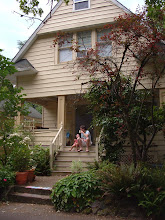
One summer morning in 2007, my two-and-a-half-year-old daughter padded downstairs to find the refrigerator in the dining room. The prep tables that had once served as extra kitchen counter space were now also in the tiny room, along with the cobalt blue microwave and the stainless steel rack that had once held dishes in the nook. SB didn't bat an eyelash. As she climbed into a chair at the dining room table, I explained that we were starting the kitchen remodel that day and she'd be going over to a neighbor's house for a few hours so her dad and I could tear the lathe and plaster off the walls. Still completely unfazed, she nodded her head agreeably and asked for a strawberry yogurt.

Although I later wondered what it must be like to grow up in a state of constant upheaval--piles of debris and tools spread throughout the house as common as piles of stuffed animals and Crayola markers, the gritty film of sheetrock dust on every flat surface, the sharp smell of varnish and paint in the air--at the time, it was simply another day in our family's life. Even in utero, SB must have heard Alex and I arguing about where to put the skylights, what color to paint the bedroom, or whether to use oak or bamboo flooring upstairs. Some kids wake up to high-rise views of the city or the smell of grass and cows in the country: SB spent her first three years enveloped in the sights, sounds, and smells of a house in progress.

My husband and I aren't flippers or remodelers: we both have full-time jobs in fields that have nothing to do with real estate or houses. Instead, we're middle-class homeowners who bought a small house in a hot real estate market and then spent the next several years transforming it into a wood-and-mortar version of who we are. In other words, we're a lot like the other young upwardly mobile American couples you might know or see at Home Depot early on Saturday mornings or read about in Sunset and Dwell magazines.
If we were just a generation older, we might have been called yuppies, but we're more akin to what David Brooks, in his 2000 book, dubbed "bourgeois bohemians" or "bobos": mid-twentieth century anti-establishment liberals who broke through the traditional stranglehold of Protestant elites at the country’s best schools and worked their way up various professional ladders to suddenly find themselves firmly on the upper and upper-middle class rungs of American society. Brooks says that because of this history, Bobos are “an elite that has been raised to oppose elites,” and, therefore, a conflicted lot—a socially enlightened, educated class that feels anxiety and guilt about their wealth and participation in consumer culture.
Brooks says that in response to this guilt, Bobos have devised a set of codes to both justify and regulate their participation in capitalism, “encouraging some kinds of spending, which are deemed virtuous, and discouraging others that seem vulgar or elitist.” Virtuous spending might include buying old or handmade things that show craftsmanship and have “soul,” or supporting local, small businesses over large, national chains.Although we’re perhaps on the tail end of the Bobo generation, Alex and I and most of our peers not only have the college diplomas and white-collar paychecks, but also guilt and anxiety about consumerism. In broad, general strokes, we are a group of people who strive to be hands-on, conscientious, political citizens who buy local goods, eat seasonal produce, and make things with our hands. Of course, this runs a wide gamut: Some people don’t own cars, grow much of their own food, and buy products from within one hundred miles of their homes. Others invest in green building and remodeling supplies and drive Priuses. Others buy mostly organic produce and eggs, use low-VOC paints, and grow native plants. But regardless of the various permutations, for most of us, our homes are both our laboratories where we experiment with materials and ideas, and our canvases on which we communicate who we are and what value.
It makes a lot of sense that Bobos use houses in political ways, because doing so justifies what is, for most middle-class homeowners, a huge expenditure and also the straightest path to wealth—less risky than the stock market and more profitable than a savings account. By renovating an old house with “soul,” building a green house on an infill lot close to public transportation, or pulling up lawn to plant vegetables, we can rationalize home ownership as virtuous spending. And on a more spiritual level, a house can be a life’s work, akin to a novel or painting or symphony. It can be justified as an aesthetic endeavor that fulfills deeper, undeniable human needs.




3 comments:
Very very interesting. What I love about this topic (and your writing style... personal but with just the right amount of analytical distance)is how I have all sorts of visceral reactions while reading... true, true, I think, nodding, then NO! when the private home is compared to a novel or symphony... I look forward to more!
Thanks for the comments and feedback. I posted another few grafs from the next chapter today, so let me know what you think.
I understand your resistance to the ideas of the private home as someone's life work, but I do think that's how some people view it. I mean, the amount of creative energy that some homeowners put into their dwellings and gardens is astounding, don't you think?
Post a Comment